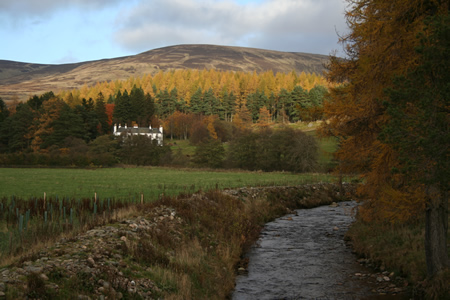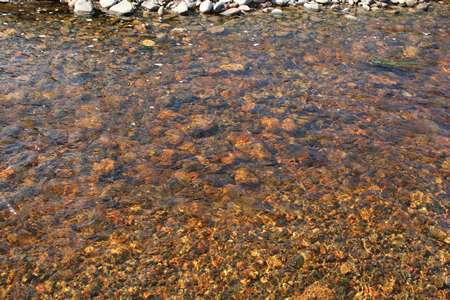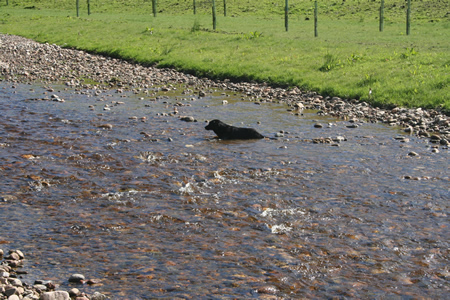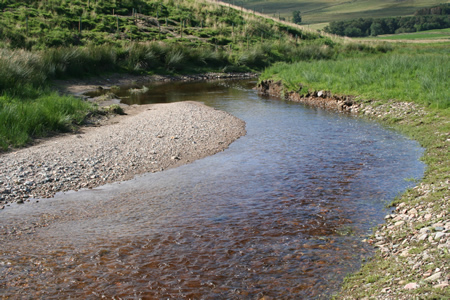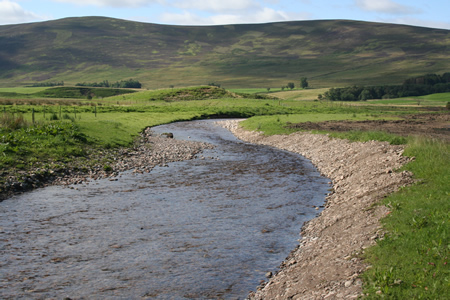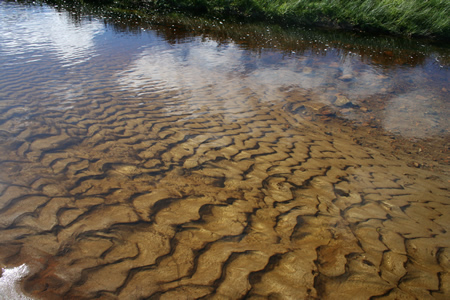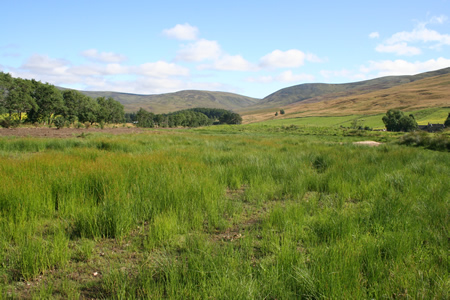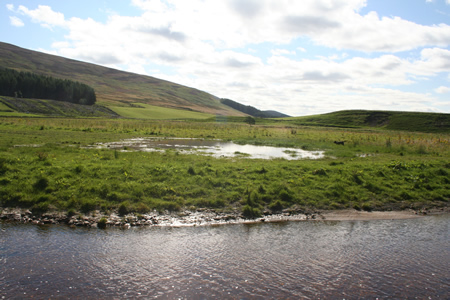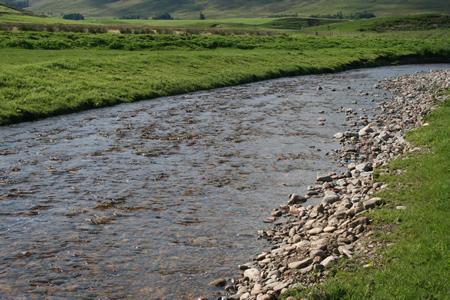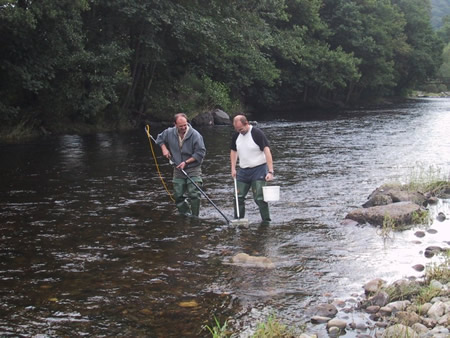These bulletin blogs represent news about Finavon and the South Esk, and my views as a riparian owner. They are not the views of any other organisation, nor are they designed to promote the interests of any individual or organisation other than Finavon Castle Water and factors affecting the fishery. Tony Andrews
The view in the photo above is from Rottal Bridge looking upstream towards the lodge. It shows what the whole burn looked like before the restoration project, which only affected the burn downstream of the bridge.
Less than a month after my first visit to the Rottal Burn to look at the restoration, I returned to see how work was progressing. I found that the original dredged channel (the ‘Rottal Ditch’ as I call it) had been filled in, and the full flow of the burn diverted into the newly formed channel.
The photograph above shows the quality of the spawning gravel and cobble in the new Rottal Burn channel.
There was a good level of water when I visited, although the burn was not in flood, my visit being in a rare lull between spates in this extraordinarily wet summer. The clear water and medium level of the burn enabled me to see in detail what had been achieved. There had been a period of high water since the completion of work, and there was ample evidence of subsequent movement of silt and gritty deposits. In sections of the burn closest to the upstream junction with the original dredged ‘ditch’ it was reassuring to see clean gravels and cobbles had already appeared. Further downstream than I had anticipated the effects of this cleaning process can now be seen, with silt deposits on the inside of bends and in the quieter depositing zones of the channel.
Tinca the Labrador enjoying the newly formed riffles in the stony channel just downstream of Rottal Bridge. This photo shows the quality of the gravels and cobbles revealed by the flows clearing away silt.
The gradient of the 1200 metres below the junction with the new channel just downstream of Rottal Bridge is such that flows remain fast, and the carrying capacity of this high energy section of the Rottal Burn should ensure that the cleaning process continues. The only part of the channel where silt deposits are likely to remain for a time at least is the section immediately upstream of the confluence with the main river, where the backup of water in spate conditions will make the last 100 metres of the channel very quiet.
View downstream to the ‘chicane’ under the planted bank. This photo clearly shows the appearance of clean gravels and the beginnings of ‘natural’ erosion on the right bank.
Early next year the main tree planting programme will take place, which will involve using indigenous trees to provide bank strengthening, shade, shelter and invertebrate habitat. With climate change predicted to give us warmer summers (joke!) it is important to mitigate against the damaging effects of warmer water temperatures in parts of the catchment used by juvenile salmonids. Dappled shade provided by carefully planted bankside trees can help reduce water temperature, as well as improving habitat in various other ways.
The appearance of the stony channel after only a couple of weeks of full flow can clearly be seen in the photograph above. This is where the adult fish of the winter of 2012/13 will (I hope) be spawning.
I have not commented on the purpose of the Rottal Burn restoration, and therefore how its success or otherwise will be measured. We may assume that the objective is to ensure that the burn produces as many naturally generated and healthy salmon and sea trout smolts as possible. The gravelly riffle of the former dredged channel offered good quality salmon spawning and habitat for fry in the post-alevin stage of life. But, as these juvenile fish grew into parr, there was probably insufficient habitat to retain them in the burn, which may have resulted in them moving downstream to the main river.
Silt on the move!
After only two weeks of full flow in the restored channel, this photo shows the ridges of gritty sand being pushed down the channel towards the main river by the high energy flow. My guess is that after the floods of the coming winter this silt will have gone, hopefully to reveal substrata of gravels and cobbles. Let’s hope that is the case, rather than more deep silt, which of course is no use as spawning habitat. A good measure for the new Rottal will be if freshwater mussels are able to colonise its gravels. Now that would be a real measure of success!
Wetland in Rottal Burn ‘delta’, formed by restored section downstream of Rottal Bridge, provides habitat for nesting and feeding birds birds, insects and amphibious reptiles.
Wetland in the Rottal flood plain. This marshy habitat provides the immediate environmental context for the estuary of the Rottal Burn as it enters the main stem of the South Esk. Good quality upland marsh provides nesting and feeding habitat for endangered wading birds, amphibians and a wide range of insects, including dragonflies, damsel flies, lepidoptera (e.g. upland butterflies and the fox and emperor moths) and many other species of birds and insects. Without this context the Rottal Burn restoration would be incomplete.
Riffle with clean stony bed. Habitat for young salmon. If the morphology of the restored burn continues the process of cleaning and exposing gravels and cobbles of this quality – and there is no reson why it shouldn’t – we can reasonably hope for successful spawning and juvenile salmon and sea trout nursery areas. Time will tell…
Above the confluence of the restored Rottal Burn with the main stem of the South Esk
I am not sure whether there are data on fish populations in the main stem of the river, or whether there may have been a threat to parr migrating into the river from the Rottal Burn from predation by resident trout. While electro fishing the ‘Rottal Ditch’ just prior to diverting the full flow into the new channel revealed a high incidence of first year fry, there appears to be a shortage of historical data on survival rates of these fry. In general it is true to state that salmon prefer riffly habitat, while trout like deeper pools. The original ditch was therefore probably better habitat for salmon up to the end of the first year than it was for sea trout. The restored burn channel appears to offer both salmon-friendly spawning and riffle habitat for fry, and deeper pools for trout. How we measure the success of spawning and survival compared to the previous regime remains to be seen. It will be interesting, for example, to see if any radio tagged salmon choose to spawn in the Rottal during the three years of the Marine Scotland project. In the meantime electro fishing should give us some idea of the species breakdown of fry and parr in the burn.
TA 30/8/2012
